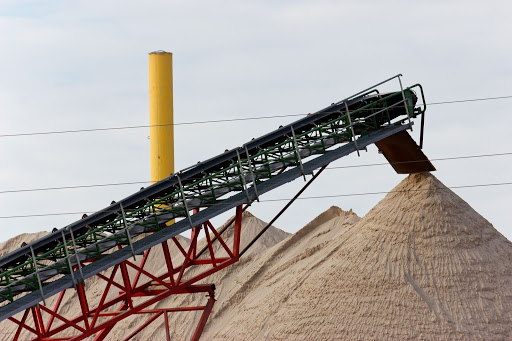Engineers Guide to Overland Conveyors
For moving large volumes of aggregate an overland conveyor offers many advantages over trucks. However, deciding between the two approaches requires a detailed understanding of what’s involved in setting up a conveyor system.
This guide addresses the main points to consider:
- Material Transport Requirements
- The Conveyor Environment
- Loading & Unloading
- Budget
- Project Timeline

Material Transport Requirements
The first question a conveyor specialist will ask is, “How many tons per hour?” This is followed by a request for details of the material to be moved.
The required tons per hour (tph) is rarely known explicitly. More likely there’s an estimate for the volume of material to transport and the project duration. The conveyor specialist will use an estimate of aggregate density combined with expected working hours to arrive at a target value for tph.
This is translated into belt width and speed requirements plus the type of belt construction and cover material needed.
The Conveyor Environment
Tons per hour isn’t enough to determine and size the drive system for an overland conveyor system. This requires information about the terrain being traversed and the local weather conditions.
Terrain encompasses distance and elevation change or changes. It’s helpful to provide a map indicating these along with any hazards or barriers that need addressing. These could include roadways and railroads along with natural features like rivers, hills, and valleys.
Wind and rain will impose additional loads on the conveyor belt and support structure. Moisture content of the conveyed material can add significant weight and lead to carryback. Wind creates side loads on the structure which become stronger as the conveyor is raised higher above the ground. Review of 100-year storm data will help indicate the intensity of wind and rain so the system design will be structurally sound.
Once these conditions are understood a conveyor specialist can determine and start to size the drive system needed. Related to this is the availability of electrical power. If there’s none or capacity is insufficient, generators will be an alternative to the power company installing additional or larger lines.
Loading & Unloading
Consider what will happen at each end of the overland conveyor. How aggregate gets onto and leaves the conveyor can add cost and complexity.
Will earthmoving machinery deposit onto the belt via hopper? Load size will govern required hopper size/capacity and may influence the type of belt needed. Will the conveyor unload via chute or just discharge onto a secondary conveyor? (Radial stacker conveyors are used in many applications.)
Budget
Having been presented with the information covered above, our conveyor engineering specialist can prepare cost estimates. The first step is to determine a route for the conveyor.
Route planning requires a careful analysis of the terrain to identify potential obstacles and explore options for crossing roads, rail, and geographic features. Google Earth is a good source and filming by drone will add additional detail. Where 3D information is needed, scanning generates point cloud data for incorporation into 3D modeling software.
Requirements for elevated sections, (or elevating the complete conveyor system,) will be reviewed. As these will need rigid truss-type supporting structure they can add considerably to the total project cost. Crossings usually need additional covers/shields to protect what’s underneath.
Once the route is selected conveyor design starts. Drawings are shared with the client and budgetary costs estimated.
Project Timeline
West River Conveyors can usually complete the design and build phases in around 20 weeks. However, it’s important to understand that the complete project, from the decision to proceed to start-up, can take 18 months. This is due to:
- Need for review and approval by your states DEQ
- Department of Transportation input on road crossings
- State DEQ input on emissions from generators, possibly also VOC emissions from compressors.
- Power company running in more lines
- Delays waiting for customer approvals
It is not uncommon to take up to 12 months to secure all the necessary approvals before the project can move forward.
Once work starts, almost all overland conveyors require some site preparation work. This typically entails pouring foundations for mounting pads and often some earth-moving. Actual installation – putting in the structure, conveyor belt, loading and unloading, and any ancillary services – could take as long as 2 months. After this, there will be a handover process, with details to be agreed with the client.
Expert Advice From West River Conveyors
For projects where there are large volumes of material to move, an overland conveyor often results in significant savings when compared with using trucks. There are also less tangible benefits such as improved safety and smaller environmental impact.
Choosing whether to use trucks or an overland conveyor requires a good understanding of what’s involved in the latter. Here we’ve highlighted the most important information West River Conveyors would need to produce cost estimates. We’ve also outlined the project process and the timeline to expect.
Designing, building, and installing an overland conveyor system is a substantial undertaking. To decide if this is something to investigate further, start by discussing your project with a conveyor specialist. West River Conveyors is ready to help.

